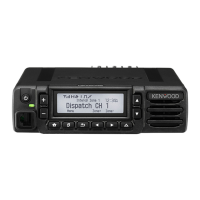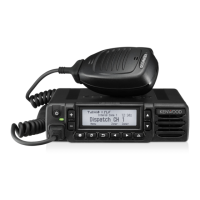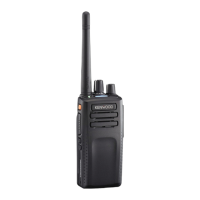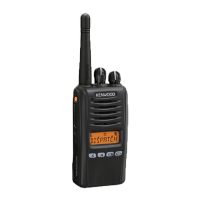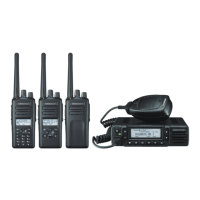
Do you have a question about the Kenwood NX-3000 series and is the answer not in the manual?
| Brand | Kenwood |
|---|---|
| Model | NX-3000 series |
| Category | Transceiver |
| Language | English |
Learn how to turn the transceiver power ON and OFF for both portable and mobile units.
Procedure for entering the correct password to unlock the transceiver if it is password protected.
Instructions on how to adjust the audio volume level for portable and mobile transceivers.
Guide to selecting the desired zone and channel for communication on the transceiver.
Steps to make a group call to parties on a conventional channel using group IDs.
Steps to make individual calls to specific persons using unit IDs.
How to make a group call on a Trunking channel using Group IDs.
How to make individual calls to specific persons on a Trunking channel.
How to receive group calls on Conventional and Trunking channels.
How to receive individual calls on Conventional and Trunking channels.
How to receive group calls on a Conventional channel in DMR mode.
How to receive individual calls on a Conventional channel in DMR mode.
Overview of accessing and using functions through the transceiver's Menu system.
Step-by-step guide on how to access the transceiver's menu and function lists.
Table detailing available functions for PF Button and Menu access across different operations.
Method to enter characters by cycling through options using up/down buttons.
Method to enter characters using the physical keypad on supported models.
Allows quick calling of programmed 2-tone lists.
Enables or disables Activity Detection, potentially triggering Emergency mode.
Enables or disables the Bluetooth function.
Pairs with or disconnects from Bluetooth devices.
Locks and unlocks transceiver buttons for security or accidental presses.
Refer to 'EMERGENCY CALLS' for information on making emergency calls.
Enables or disables the GPS function.
Activates Group Call Mode.
Refer to 'Making Individual Calls' for instructions.
Enables or disables the Lone Worker function.
Views current Trunking site and searches for new sites.
Sets a password to lock the transceiver.
Details on how to use the Scan function for monitoring channels.
Information on setting up and using Priority channels for scanning.
Instructions for programming the scan list and channels.
How to reprogram Priority channels if set as Operator Selectable.
Instructions for making DTMF calls via manual dialing or keypad.
Function used to disable transceiver if stolen or lost.
Steps to make telephone calls in NXDN Trunking using Autodial or Manual Dialing.
How to reprogram the Autodial list to add or delete DTMF Codes.
Steps to make telephone calls in LTR Trunking using Manual Dialing or Autodial.
Steps to send status messages to other units.
Procedure for initiating emergency calls from portable and mobile units.
How to switch the transceiver to secure (encrypted) transmission.
Steps to select or change the scrambler code.
Steps to select or set a new encryption key.
Procedure for deleting encryption keys.
Explanation of QT/DQT signaling for ignoring calls.
How to reprogram QT/DQT tones or codes using a programmed button.
Explanation of RAN signaling for digital radio communications.
Overview of optional signaling types like 2-tone, 5-tone, DTMF, MDC-1200, FleetSync, NXDN ID.
Steps to set or adjust the transceiver's built-in clock.
How to change the language for text display and voice announcements.
How to change the screen display to a simpler layout without button guides.
How to make and receive selective calls to/from stations or groups.
How to send and receive status messages.
How to transmit GPS data manually or automatically.
How to make and receive selective calls using 5-tone signaling.
How to send and receive status messages with 5-tone signaling.
Sets the microphone input sensitivity for VOX operation.
Procedure for activating and using the VOX function for hands-free transmission.
Explanation of the Time-out Timer to prevent extended channel use.
Function to extend battery life by reducing consumption during standby.
Alerts when the battery needs recharging, showing power status.
Prevents transmission on an already in-use channel.
Details on Bluetooth version, power class, profiles, and device class.
Procedure to select the type of Bluetooth headset for HSP connection.
Instructions to turn the Bluetooth function ON or OFF.
How the transceiver automatically searches for Bluetooth devices.
Steps to connect and pair Bluetooth devices like headsets.
How to activate the microphone of the Bluetooth headset for calls.
Steps to connect the transceiver to a PC using Serial Port Profile.
How to manage registered Bluetooth devices via the My Devices menu.
Procedure to connect a registered Bluetooth device.
Procedure to disconnect a registered Bluetooth device.
Procedure to delete a registered Bluetooth device.
How to view information (Name, Address, Class) of registered Bluetooth devices.
How to switch audio output between transceiver and Bluetooth headset.
Indicates the Bluetooth function is not working properly.
Indicates no device was found in Bluetooth Find Device Mode.
Indicates no response from Bluetooth device during pairing or connection.
Indicates Bluetooth device rejected pairing or connection request.
Indicates Bluetooth device does not support Headset Profile (HSP).
Records and retains conversations, storing them in built-in memory.
Stores GPS data temporarily in RAM and permanently in built-in memory.
How to play back voice recordings from Auto Recording.
Procedure to delete a single voice recording.
Displays the strength of received calls.
Displays the battery power status.
Indicates High, Medium, or Low transmit power.
Indicates Bluetooth connection status and activation.
Shows Scan, Priority Scan, or Roaming progress.
Shows when Encryption (AES, DES, Enhanced) is activated.
Indicates when the VOX function is activated.
Shows when auxiliary functions (AUX A, B, C) are activated.



